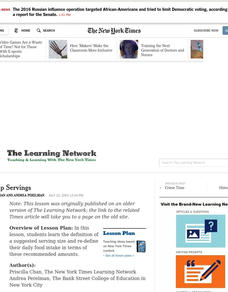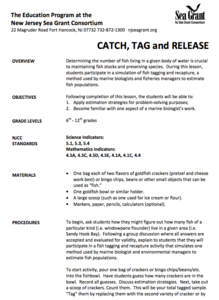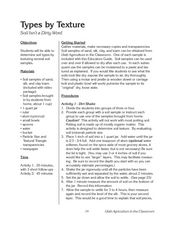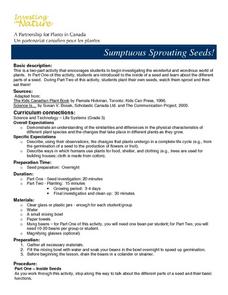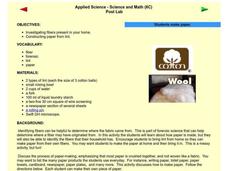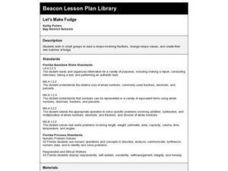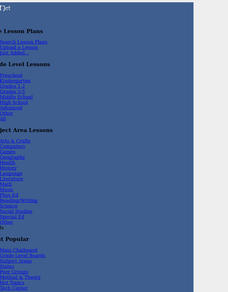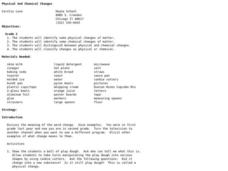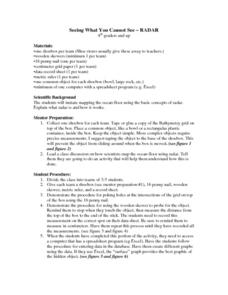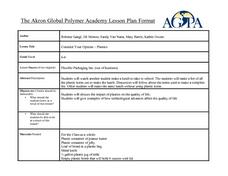Curated OER
Sizing Up Servings
Students learn the definition of a suggested serving size and re-define their daily food intake in terms of these recommended amounts.
Curated OER
Catch, Tag, and Release
Learners discover how fish tagging is used by marine biologists and fisheries to estimate fish populations. Participating in a simulation, students use estimation to determine the whole population from a small number of items.
Curated OER
States of Matter: Solids, Liquids and Gases
Learners explore various states of matter. In this science lesson plan, students recognize the properties of each state of matter and recognize the similarities and differences between the three states of matter.
Curated OER
Types by Texture: Soil Isn't a Dirty Word
Second graders experiment with different types of soil to find the texture. In this types of soil experiment, shake a jar of soil and water and record the settling of the soil. Students record again after 3-4 hours and note the level...
Curated OER
The Water Cycle
Learners simulate the water cycle. In this water cycle lesson, students create a model of the water cycle. Learners draw the water cycle and write a paragraph explaining their drawing.
Curated OER
Sumptuous Sprouting Seeds!
Third graders investigate the wonderful and wondrous world of plants. They examine the inside of a seed, explore the different parts of a seed, plant their own seeds, watch them sprout and then eat them! They describe, using their...
Curated OER
We're Alike, We're Different!
Students compare a variety of people counters to determine how they're alike and different and then sort, classify and write about how they sort and classify people counters.
Curated OER
Applied Science - Science and Math Post Lab
Students construct paper. In this applied Science instructional activity, students create paper using lint. Students investigate the different fibers in their homes.
Curated OER
Let's Make Fudge
Students make fudge after reading fractional values in recipes and finding equivalent fractions to those presented in the recipes. They study measurement abbreviations.
Curated OER
Ocean Floor Model
Students construct a simulated model of the ocean floor in a shoe box. They determine that the floor of the ocean is composed of hills, plains, ridges, trenches, and sea mounts. They draw out a plan for their ocean floor which includes...
Curated OER
Air Pressure
Students examine air pressure. In this air pressure lesson, students perform a series of experiments to evaluate the effects of air pressure.
Curated OER
Unraveling the Web
Students consider how a message might be traced along a complex network, then explore backbone maps as a basis for understanding the purpose and structure of the Internet.
Curated OER
Shapes
Students differentiate objects based on contrast in physical characteristics such as color, texture, size and shape. They also recognize and sort objects by color families.
Curated OER
Art, Naturally
Learners read an online article which examine different works of art. They study how patterns and shapes found in nature influence art. Finally, they create original works of art and write artist's statements.
Curated OER
Physical And Chemical Changes
Second graders identify physical and chemical changes of matter. They distinguish between physical and chemical changes. They classify changes as physical or chemical.
Curated OER
Mapping and Excavating a Jello Mold
Students simulate how archaeologists excavate sites by "searching" their own site in the form of a Jello mold. They use a grid to map the objects in the Jello mold as well as looking at three layers of Jello to understand stratigraphy...
Curated OER
Being There: Exploring China And Japan
Students discover the culture, society, geography, and history of Asia through games, food, art, and literature in this multi-day lesson about China and Japan. An exciting lesson for upper-elementary or lower-middle school classrooms.
Curated OER
Edible Four-Layer Earth
This lesson is designed to come after students have studied about the four main layers of the earth. They may relate the size of the sections to known objects such as the mantle to the size of a grapefruit and the outer core to the size...
Curated OER
Lesson 2 Its a Small World (Day 2)
Students are able to explain how the water cycle recycles the earth's water supply. They are able to make use of the knowledge of land forms learned in social studies. Students are able to form a hypothesis on how/why the water cycle...
Curated OER
Wind and Currents
Students observe how wind generates currents and the effect of islands and banks on currents. They determine ocean circulation affects climate and plant and animal populations on land and in the ocean and that surface currents are...
Curated OER
Seeing What You Cannot See--RADAR
Student imitate mapping the ocean floor using the basic concepts of radar. Then they explain what radar is and how it workds. All of their measurements are recorded on a data sheet. Then the data is entered into a spreadsheet program. A...
Curated OER
Consider Your Options-Plastics
Learners explore plastics and what plastics students use to pack a lunch. In this plastics lesson plan, learners observe each other pack lunches and take note of all the plastics used in packing the lunch. They discuss the impact of...
Curated OER
Rising Sea Levels: UK and Bangladesh
Learners explore the possible effects of global warming. In this geography/global warming lesson, students identify regions using an atlas and complete a global warming worksheet. Learners perform an experiment in which they simulate...


